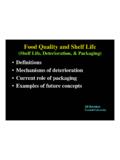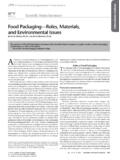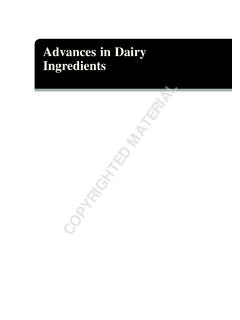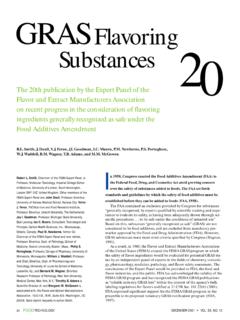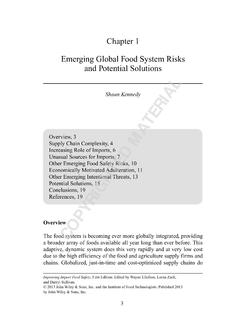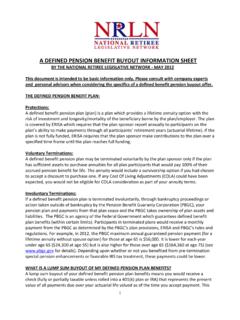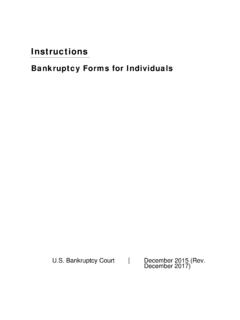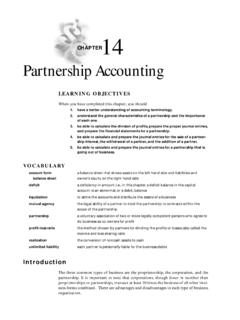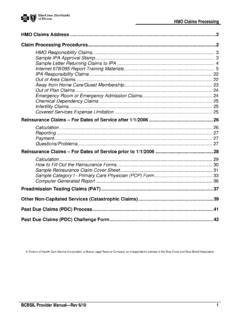Transcription of Sensory Evaluation - IFT.org
1 55 Sensory Evaluation | Is Seeing Believing?IS SEEING BELIEVING?BackgroundAll of the senses are important when eating. Think about eating a potato chip fi rst you see the chip (maybe you notice if it has any dark/burnt spots?). Next you touch it (maybe you notice if it s greasy, or if it s thick?). Then as you bring the chip to your mouth you smell it (maybe you smell the seasoning? Or the oil it was fried or baked in?), then you eat it and hear the crunch of the chip, and you probably also taste the saltiness (maybe you also experience some additional fl avor?). Imagine if any one of these experiences was missing would a chip be the same if you didn t hear it crunch in your mouth?ReferencesLawless, HT and Heymann, H. 1998. Sensory Evaluation of Food: Principles and Practices.
2 New York: Chapman & , H and Sidel, JL. 1993. Sensory Evaluation Practices. 2nd ed. Academic Press: San EVALUATIONS ensory Evaluation is defi ned as A scientifi c discipline used to evoke, measure, analyze, and interpret those responses to products that are perceived by the senses of sight, smell, touch, taste, and hearing (Stone and Sidel 1993). 56 Sensory Evaluation | Is Seeing Believing?The following experiment was prepared by Sarah levels: 9-12 Estimated Preparation Time: 30 minutesEstimated Activity Time: 30 minutesStandard Addressed: Content Standard C (Behavior of Organisms)Multicellular animals have nervous systems that generate behavior. Nervous systems are formed from specialized cells that conduct signals rapidly through the long cell extensions that make up nerves.
3 The nerve cells communicate with each other by secreting specifi c excitatory and inhibitory molecules. In sense organs, specialized cells detect light, sound, and specifi c chemicals, and enable animals to monitor what is going on in the world around :To introduce Sensory science to students To have students voluntarily participate in a Sensory test To demonstrate the effects of sight on your ability to identify and distinguish the taste of beverages (Note: Be aware that some students may have food allergies or sensitivities)Materials: 2 2 liters of lemon lime soda (ex., Sprite or Sierra Mist) Red and blue food coloring 6-8 oz. plastic cups (total should equal 2 times the number of students)Marker Ballots Calculators Set-up Procedures: Before class, color one 2-liter bottle of soda purple by adding 1.
4 Approximately 20 drops of red food coloring and 20 drops of blue food coloring into the bottle. Gently shake the bottle to disperse the class, color the other 2-liter bottle of soda red by adding 2. approximately 20 drops of red food coloring into the bottle. Gently shake IS SEEING BELIEVING?Administrator s Guidethe bottle to disperse the half the cups with a random three-digit code (for example, 209), 3. label the other half of the cups with a different random three-digit code (for example, 047). There should be enough labeled cups so that each student receives one of each : If there are 12 students in the class, there should be 12 cups labeled 209 and 12 cups labeled before the test, pour one of the beverages into one set of 4. labeled cups, and pour the other beverage into the remaining : Pour the purple beverage into the cups labeled 209 and the red beverage into the cups labeled the order of presentation for each student half the students 5.
5 Should receive the purple beverage (209) fi rst, half the students should receive the red beverage (047) fi rst. Example:Balanced Random Code Presentations:Student #1 receives sample order: 209, 047 Student #2 receives sample order: 047, 209 Student #3 receives sample order: 047, 209 Student #4 receives sample order: 047, 209 Student #5 receives sample order: 209, 047 Student #6 receives sample order: 047, 209 Student #7 receives sample order: 209, 047 Student #8 receives sample order: 209, 047 Student #9 receives sample order: 047, 209 Student #10 receives sample order: 209, 047 Student #11 receives sample order: 047, 209 Student #12 receives sample order: 209, 047 Student #13 receives sample order the same as Student #1, and so the ballots (Total should equal 2 times the number of students; 6.)
6 See next page for photocopies).7. Prepare the data : This demonstration can also be done using colorless fl avored water. For example, purchase two 1-liter bottles of fl avored water (such as Fruit2O raspberry) and color one bottle red with red food coloring and one bottle purple with red and blue food coloring. Follow the directions above for preparation and serving. Source: Jason Bolton, So There are Five Basic Senses, prepared as part of the NSF GK-12 Sensors Fellowship, University of sweet is sample?How sour is sample?How intense is the fruit fl avor of sample?How sweet is sample?How sour is sample?How intense is the fruit fl avor of sample?57 Sensory Evaluation | Is Seeing Believing?Photocopy enough ballots for each student and write in the sample :Comments:Taste sample _____ and circle the box that represents the intensity of that sample _____ and circle the box that represents the intensity of that sweetExtremely sweetExtremely sourExtremely sourExtremely intenseExtremely intenseNot sweet at allNot sweet at allNot sour at allNot sour at allNot intense at allNot intense at all58 Sensory Evaluation | Is Seeing Believing?
7 Data Sheet:Attribute #StudentRed Beverage Purple Beverage1234567891011121314151617181920 Mean (x)Standard Deviation59 Sensory Evaluation | Is Seeing Believing? Sensory Test Procedures:Students can voluntarily participate, but should not be forced to 1. participate because all Sensory tests that include human subjects must be conducted on a voluntary basis. Present the two drinks to students one at a time. Remember half 2. of the students should receive the purple beverage fi rst, and half of the students should receive the red beverage fi rst. Each student should also have a cup of water. Direct the students to have a sip of water in between total number of studentsX1= rating for student #1X= MeanExample Standard Deviation Calculation: Red Beverage Standard Deviation = ((1/6)*(7-7)2 + (8-7)2 + (7-7)2 + (7-7)2 + (6-7)2 + (7-7)2 Standard Deviation = ((1/6)*((0) 2 + (1) 2 + (0) 2 + (0) 2 + (-1) 2 + (0)2) Standard Deviation = ((1/6)*(2)) = Data Sheet: Attribute #1: SweetnessStudentRed Beverage (X1)Purple Beverage175284376475565675 Mean (x)75 Standard Deviation = (1/N * ((X1-X) 2 +(X2-X) 2 + (X3-X) 2 + (X4-X) 2 + (X5-X) 2+ (X6-X) 2)Ask the students:Did you rate the sweetness levels of the two beverages differently?)))
8 1. Did other members of the class rate the sweetness about the same?2. What about the sour or fruit fl avor?3. What fl avors do you think the two samples are?4. What affected your rating?5. What other changes could be made to the beverages that would affect the ratings?6. Give students the ballot and ask them to rate the intensity of each 3. attribute on the 9-point scale. Have each student fi ll in the data sheets in the front of the class 4. with their scores for each attribute (1=Not sweet at all, 9=Extremely sweet).If time allows, calculate averages (means) and standard 60 Sensory Evaluation | Is Seeing Believing?IS SEEING BELIEVING?Student HandoutBackground: Humans have fi ve senses: taste, smell, touch, sight, and sound. All of the senses are important when eating.
9 Think about eating a potato chip fi rst you see the chip (maybe you notice if it has any dark/burnt spots?). Next you touch it (maybe you notice if it s greasy?) or if it s thick?). Then, as you bring the chip to your mouth, you smell it (maybe you smell the seasoning?) or the oil it was fried or baked in?). Then you eat it and hear the crunch of the chip, and you probably also taste the saltiness (maybe you also experience some additional fl avor?). Imagine if any one of these experiences was missing would a chip be the same if you didn t hear it crunch in your mouth?Objective: To experience the effects of sight and smell on your ability to identify and distinguish the taste of foods and beverages. Procedures: You have just tasted two beverage samples and rated the intensity of 1.
10 Each attribute on the 9-point scale. Fill in the data sheets in the front of the class with your scores for 2. each attribute (1=Not sweet at all, 9=Extremely sweet).If time allows, calculate averages (means) and standard deviations. 3. Conclusion Questions:Did you rate the sweetness levels of the two beverages differently?1. Did other members of the class rate the sweetness about the same?2. What about the sour or fruit fl avor?3. What affected your rating?4. What other changes could be made to the beverages that would affect the ratings?5.
